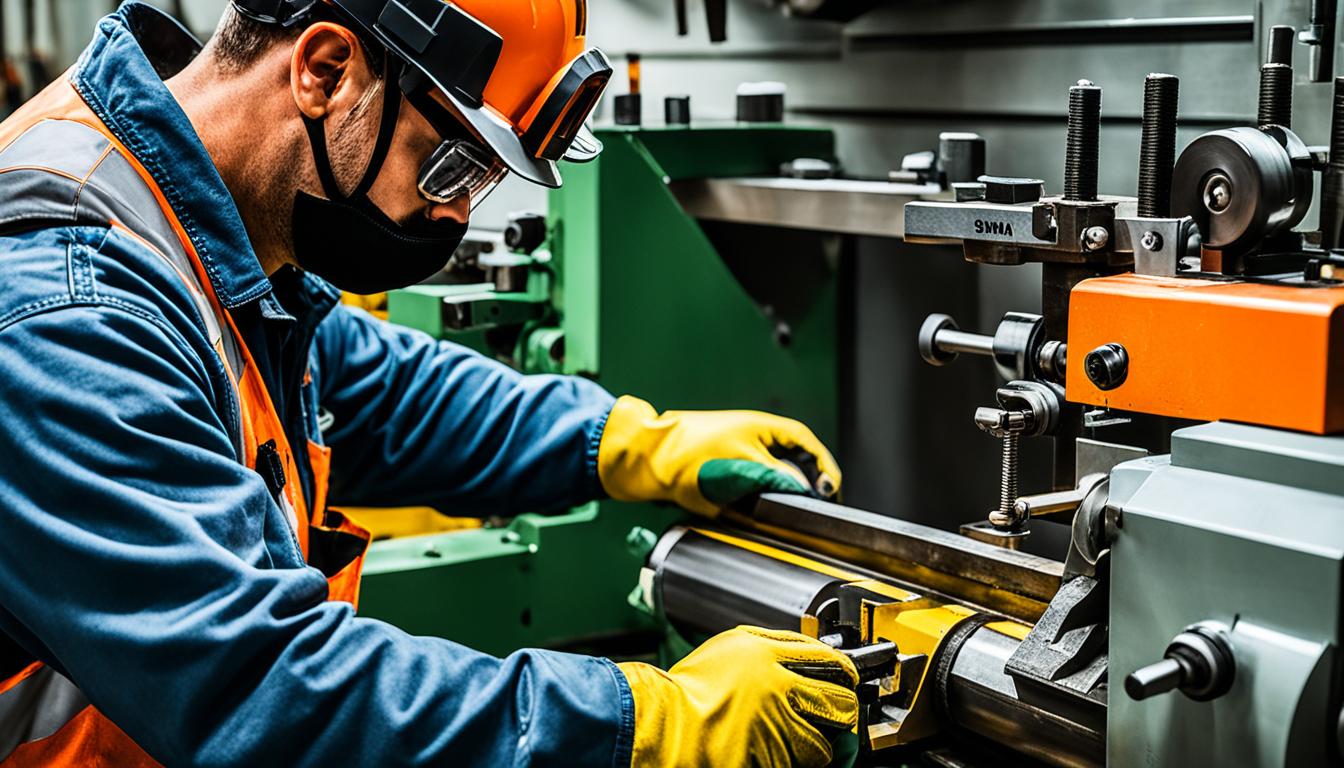Lathe machine usage requires strict adherence to safety protocols and best practices to ensure efficient operation and prevent accidents. Operators must always wear appropriate personal protective equipment, including safety glasses, hearing protection, and close-fitting clothing to avoid entanglement. Before starting the lathe, it’s crucial to inspect the machine for any loose parts or damage, and ensure all guards are in place. Proper workpiece mounting is essential; use the correct chuck or faceplate and ensure the workpiece is securely fastened.
When operating the lathe, maintain a clean work area, use sharp cutting tools, and select appropriate speeds and feeds for the material being machined. Never leave the lathe running unattended, and always stop the machine before taking measurements or adjusting the workpiece. Regular maintenance, including lubrication and cleaning, is vital for optimal performance and longevity of the lathe. By following these essential tips and prioritizing safety, operators can maximize productivity while minimizing risks associated with lathe machine usage.
- Read the owner’s manual and undergo proper training before operating a lathe.
- Wear appropriate safety glasses and remove entanglement hazards.
- Keep the floor free from obstructions.
- Follow job specifications for speed, feed, and depth of cut.
- Use a lifting device for heavy chucks or workpieces.
Lathe Machine Safety Tips
When operating a lathe machine, prioritizing safety is crucial to prevent accidents and injuries. By following these essential safety tips, you can ensure a secure and productive lathe machine operation.
1. Protective Gear:
Always wear appropriate safety glasses to shield your eyes from flying debris and particles. Remove any loose clothing, jewelry, or accessories that may become entangled in the machine.
2. Clear Workspace:
Keep the floor area around the lathe machine clear of obstructions to prevent tripping hazards. Ensure easy access to start/stop and emergency stop buttons for quick response in case of an emergency.
3. Job Specifications:
Adhere to the recommended job specifications for speed, feed, and depth of cut provided by the manufacturer. Using the correct settings ensures safe and efficient machining processes.
4. Lifting Devices:
When handling heavy chucks or workpieces, use a lifting device to prevent strains and accidents. This helps maintain stability and reduces the risk of dropping or mishandling heavy components.
5. Chuck Inspection:
Regularly inspect the chucks for wear, damage, or excessive buildup of chips and debris. Replace worn or damaged chucks to maintain optimal grip and prevent accidents.
6. Chuck Wrenches:
After adjusting the chuck, remember to remove the chuck wrenches immediately. Accidents can occur if the wrenches are left attached and the lathe is started.
7. Barrier Guards:
When operating the lathe machine in semi-automatic or automatic mode, use barrier guards to protect against accidental contact with rotating components.
8. Power Transmission Parts:
Ensure that all power transmission parts are guarded to prevent unintentional contact. This reduces the risk of entanglement or injuries caused by rotating belts, pulleys, or gears.
9. Clear the Saddle and Bed:
Remove all tools, gauges, or other objects from the saddle or lathe bed before starting the machine. This eliminates the risk of interference during operation.
By following these lathe machine safety tips, you can minimize the risk of accidents and create a safe working environment. Prioritizing safety ensures that you can operate the lathe machine efficiently while protecting yourself and those around you.
Common Mistakes to Avoid
When using a lathe machine, it is important to be aware of and avoid common mistakes that can lead to accidents and compromise safety. By understanding these mistakes, you can better protect yourself and ensure efficient and effective operation of the lathe machine.
Entanglement Hazards
One common mistake is wearing gloves, rings, watches, or loose clothing while operating a lathe machine. These items can get caught in the moving parts of the machine, posing serious entanglement hazards. Always remove any jewelry and wear proper attire, including safety glasses and appropriate clothing that fits snugly and does not hang loose.
Unsafe Work Practices
Leaning on the machine or placing hands on a workpiece while it is turning are unsafe practices that should be avoided. This can result in injuries if the workpiece suddenly starts moving or if hands come into contact with rotating parts. Additionally, using calipers or gauges while the machine is in motion can lead to accidents. It is important to keep hands clear of the lathe’s rotating components at all times.
Incorrect Cutting Techniques
Making heavy cuts on long slender pieces can cause the work to bend or fly out of the lathe, posing a risk to the operator. It is crucial to follow recommended cutting techniques and guidelines provided by the lathe manufacturer to ensure safe operation. Avoid excessive force and always use appropriate cutting tools for the task at hand.
Unsafe Adjustments and Measurements
Never make adjustments to the lathe machine while it is in operation. This includes changing settings or modifying the workpiece without stopping the machine first. Additionally, avoid taking measurements or clearing cuttings while the lathe is still in motion. Wait for the lathe to come to a complete stop before making any adjustments or performing any tasks that require close interaction with the machine.
Common Mistakes to Avoid When Using a Lathe Machine
| Mistake | Description |
|---|---|
| Wearing Gloves, Rings, Watches, or Loose Clothing | Potential entanglement hazards that can cause injuries. |
| Leaning on the Machine or Placing Hands on a Turning Workpiece | Unsafe practices that can lead to accidents. |
| Using Calipers or Gauges While the Machine is Moving | Potential for accidents due to hand-machine interaction. |
| Making Heavy Cuts on Long Slender Pieces | Risk of workpiece bending or flying out of the lathe. |
| Performing Adjustments or Measurements While the Machine is Operating | Unsafe practices that can result in accidents. |
Avoiding these common mistakes is essential for maintaining a safe working environment and ensuring the longevity of the lathe machine. By adhering to proper safety protocols and adhering to recommended operating procedures, you can minimize the risk of accidents and maximize the productivity of your lathe machine.
Troubleshooting and Maintenance
Regular maintenance plays a crucial role in ensuring the efficient operation of a lathe machine. By diligently performing maintenance tasks, you can prevent costly breakdowns and extend the lifespan of your machine. Here are some essential maintenance tips to keep in mind:
- Inspect and replace worn parts: Regularly check for any signs of wear or damage on the lathe machine’s components, such as belts, gears, and bearings. Replace any worn or damaged parts promptly to avoid further problems.
- Clean the machine: Keep the lathe clean and free from debris or clutter that may affect its performance. Regularly remove chips, dust, and other debris from the machine’s bed, chuck, and other areas.
- Check and adjust the speed: Ensure that the rotation speed of the lathe is set correctly for the specific task at hand. High speeds can cause excessive vibration and wear, while low speeds may affect cutting efficiency. Refer to the manufacturer’s guidelines for the recommended speed settings.
- Align and adjust components: Proper alignment and adjustment of the lathe machine’s components are vital for accurate and precise machining. Regularly check and align the tailstock, tool rest, and other movable parts to maintain optimal performance.
- Follow manufacturer guidelines: Always refer to the manufacturer’s maintenance guidelines for your specific lathe machine model. These guidelines provide valuable insights into recommended maintenance schedules, lubrication requirements, and troubleshooting tips.
By following these lathe machine maintenance tips, you can ensure that your machine operates smoothly and efficiently, minimizing the risk of unexpected downtime and maximizing productivity.
Additionally, troubleshooting occasional issues that may arise with a lathe machine can help maintain its performance. Here are some common troubleshooting tips:
- If experiencing vibration or excessive noise, check if the lathe machine is properly leveled and secured to the floor. Misalignment or loose mounting can cause these issues.
- Incorrect or misadjusted tooling can affect the quality of the machined parts. Verify that the tooling is properly installed, sharp, and securely fastened.
- If the lathe machine’s motor fails to start, check the power supply, fuses, and electrical connections. A faulty switch or motor may require professional assistance.
- Uneven or inaccurate cutting may result from worn or damaged cutting tools. Regularly inspect and replace dull or damaged tools to ensure precise machining.
- If experiencing erratic or inconsistent feed rates, inspect the feed mechanism for any blockages, jams, or misalignments. Lubricate as per manufacturer recommendations.
Remember, addressing any troubleshooting issues promptly can help avoid further damage to your lathe machine and ensure continuous productivity.

Maximizing Efficiency
To maximize the efficiency of a lathe machine, it is essential to develop key lathe machine skills and adopt effective practices. By employing the right techniques and making informed decisions, operators can achieve superior results with their lathe machines. Here are some crucial strategies to enhance efficiency:
1. Rotating Speed and Cutting Tools
Choosing the appropriate rotating speed is crucial for achieving optimal performance. It is advised to refer to the manufacturer’s guidelines or a speed chart for the recommended RPM (rotations per minute) based on the material and operation. Additionally, using the correct cutting tools for specific tasks is vital. High-quality tools with sharp edges yield precise and efficient cuts.
2. Tool Rest and Tool Height Adjustment
The positioning of the tool rest and tool height significantly impacts the outcome of lathe operations. Properly adjusting the tool rest ensures stability and prevents unwanted vibrations. Adjusting the tool height allows for accurate shaping and cutting, contributing to enhanced efficiency.
3. True and Centered Work
Ensuring that the workpiece runs true and centered within the lathe machine is essential. Correct alignment minimizes errors and reduces material waste. It is advisable to use alignment tools, such as dial indicators or center finders, to achieve precise alignment.
4. Feed Rates and Depths of Cut
Using appropriate feed rates and depths of cut is crucial for optimizing efficiency. Consistent and controlled feed rates enable smoother transitions and better surface finishes. Moreover, selecting suitable depths of cut helps prevent excessive tool wear and material wastage.
5. Maintaining Sharp Cutting Tools
Regularly inspecting and sharpening cutting tools is necessary to maintain efficiency. Dull tools not only produce subpar results but also increase the strain on the lathe machine. By ensuring sharp cutting edges, operators can achieve faster, cleaner, and more accurate cuts.
6. Cleaning and Debris Management
Regularly cleaning the lathe machine is essential for its optimal functioning. Clearing away debris, such as chips and dust, prevents interference and reduces the risk of errors or accidents. It is advisable to clean the machine thoroughly after each use and remove cuttings only after the lathe has stopped moving.
By implementing these essential lathe machine skills and practices, operators can maximize the efficiency of their lathe machines. These strategies not only enhance productivity but also contribute to the overall safety and longevity of the equipment.
Important Considerations
When using a lathe machine, it is essential to keep in mind several important considerations. By following these guidelines, you can ensure safe and efficient operation:
- Maintain an upright posture and avoid leaning on the machine while it is operating. This helps prevent accidents and promotes better control.
- Keep a safe distance from the workpiece to avoid any potential projectile-induced accidents. This precaution is especially important when working with rotating parts.
- Always consult a speed chart to determine the appropriate RPM (Rotations Per Minute) for the lathe machine. Operating at the correct speed reduces the risk of damage or instability.
- Ensure the workpiece is stable and properly secured before starting any sanding or polishing tasks. Additionally, it is crucial to remove the tool rest to prevent any accidents or damage to the lathe.
- Regularly inspect the lathe machine for worn parts and damaged components. By conducting routine maintenance, you can address any issues promptly, ensuring safe and efficient operation.
By incorporating these important considerations into your lathe machine usage, you will be able to work effectively while minimizing the risk of accidents or damage.

Filing Precautions
Filing is a crucial task performed on a lathe machine, but it can also be risky if proper precautions are not taken. To ensure your safety while filing, it is essential to follow these precautions:
- Grip the file with the hand closest to the stock and use the other hand to guide and direct the file. This technique helps prevent accidents and provides better control.
- Cover the lathe bed with paper to protect it from metal chips and debris generated during the filing process.
- Set the lathe machine at an appropriate speed for the filing operation. Consult the lathe’s manual or an experienced operator for guidance.
- Move the file along the workpiece with long, smooth strokes to achieve an even and precise filing result.
- Clean the loaded file using a file brush to remove any metal chips or debris that may accumulate on it. This ensures optimal performance and prolongs the life of the file.
- Avoid using compressed air to clear metal chips as it can cause them to fly around and pose a safety hazard. Instead, use alternative methods such as a brush or vacuum cleaner.
By following these filing precautions, you can enhance your safety and maintain the efficiency of your lathe machine during filing operations.
Other Safety Gear and Precautions
When operating a lathe machine, it is important to prioritize safety by using appropriate safety gear and taking necessary precautions. In addition to wearing safety glasses to protect your eyes, it is crucial to guard your face from high levels of dust produced during filing and sanding tasks. Consider using safety masks that cover your nose and mouth to ensure respiratory protection.
Another important safety measure is to minimize exposure to loud lathe-operating sounds. Wearing earplugs can help protect your hearing and prevent long-term damage caused by prolonged exposure to noise.
To further prevent accidents and entanglement hazards, it is essential to tie up loose clothing, secure open hair, and remove any jewelry or ornaments before operating the lathe machine.
When clearing metal chips from the machine, it is advisable to use pliers or brushes instead of your hands. This will help prevent accidental injuries caused by sharp edges or rotating parts.
Additionally, it is important to exercise caution when handling hot objects from the machine. Allow them to cool down before touching them to avoid burns or other accidents.
Choosing a Lathe Machine
When it comes to selecting a lathe machine, there are several important factors to consider. One of the key considerations is the reputation of the brand. Emtex is a renowned brand known for manufacturing high-quality lathe machines that meet the needs of various industries.
Availability is another critical aspect to keep in mind. With the convenience of online shopping, users can easily purchase lathe machines. However, it is essential to choose a reliable supplier that offers genuine products and excellent customer service.
Dependability is of utmost importance when investing in a lathe machine. It is crucial to select a machine that is durable and built to withstand heavy-duty usage. Additionally, proper training and understanding of the machine’s usage and safety guidelines are vital to ensure optimal performance and minimize the risk of accidents.
Lastly, the specific requirements and tasks you will be performing with the lathe machine should determine the most suitable option for your needs. Whether it’s small-scale projects or large-scale industrial applications, considering the size, power, and capabilities of the machine will help you make an informed decision.
